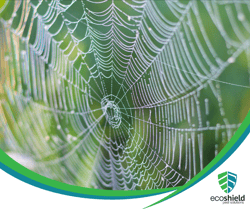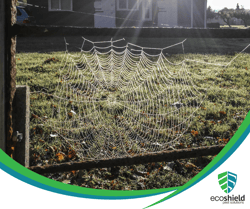As the days grow shorter and cooler, homeowners often find themselves sharing their living spaces with unexpected (and unwanted!) visitors – spiders. Arachnids have long been a source of curiosity and often fear for many of us. A mystery that often piques our interest as humans is whether or not spiders ever reuse their intricate webs. Join us as we explore the habits and behaviors of these web-spinning wonders, shedding light on their captivating, yet often misunderstood, lives.
Why Do Spiders Build Webs?
Furthermore, spiders' webs are not solely designed for hunting; they also serve as safe shelters. Many spider species create intricate hideaways within their webs, tucked away from potential predators and adverse weather conditions that threaten their safety. These shelters provide a secure space for the spider to rest, molt, lay eggs, and even mate.
Moreover, web-building is actually a fundamental aspect of spider courtship rituals. In certain species, males construct smaller, secondary webs near a female's larger web to woo her. These intricate displays of silk serve as a means of communication between potential mates, showcasing the male's suitability as a partner. It's a testament to the versatility of spider silk and the many functions it serves in their lives.
Lastly, the silk produced by spiders is not just a tool for survival; it's a resource that can be recycled. It’s true! Spiders often consume and digest their old webs, reclaiming the valuable proteins and nutrients needed to construct new ones. This ability to reuse silk resources demonstrates the spider's remarkable adaptability and resourcefulness in their quest for survival.
What Are Spiderwebs Made Of?
 Spider silk is primarily made up of proteins, with several specialized silk glands within a spider's abdomen solely responsible for its production. These proteins are secreted in a liquid form and begin to solidify as they are extruded through tiny spinnerets located at the rear of the spider's abdomen. The silk produced is incredibly strong and lightweight, making it ideal for a variety of purposes.
Spider silk is primarily made up of proteins, with several specialized silk glands within a spider's abdomen solely responsible for its production. These proteins are secreted in a liquid form and begin to solidify as they are extruded through tiny spinnerets located at the rear of the spider's abdomen. The silk produced is incredibly strong and lightweight, making it ideal for a variety of purposes.
Interestingly, different types of silk glands produce silk with distinct properties. For example, dragline silk, which forms the framework of many spiderwebs, is remarkably strong and is often used for structural support. This silk contains proteins that arrange themselves in a way that results in exceptional tensile strength, allowing it to bear the weight of the spider as it moves across its web, as well as support the weight of their prey.
In addition to dragline silk, spiders can produce other types of silk for highly specialized purposes, such as capturing prey or even wrapping eggs. These silks may have different chemical compositions and physical properties to suit their intended functions. For example, the sticky silk used to trap prey is coated with an adhesive substance that aids in capturing insects, ensuring they cannot break free once they're snagged in a spider’s web.
Are Spiderwebs Reused?
The answer is: kind of. Spiderwebs are not typically reused in the way that we might recycle materials like paper or plastic. Instead, spiders often construct new webs as needed rather than continually repairing or reusing old ones. Why? Well, there are several reasons for this behavior.
Firstly, spiderwebs are designed for specific purposes, such as catching prey. Over time, the sticky silk and structural elements of a web can become damaged, dirty, or lose their general effectiveness. A web that has caught and immobilized numerous insects may be covered in detritus, or dead particulate organic material, making it less effective on fresh prey. Therefore, many spiders prefer to create a new, clean web when their current one becomes less functional or damaged.
Secondly, the act of constructing a web consumes a considerable amount of energy and resources for a spider. Recycling an old web by consuming and digesting its silk can help reclaim some of these resources, which the spider can then use to build an entirely new web. This process is known as web recycling, and it's a common behavior among many spider species. However, web recycling is not the same as reusing an entire web structure.
Lastly, some spider species, such as orb-weaving spiders, may rebuild their webs regularly, even as often as on a daily basis. These spiders typically consume the old web each morning and construct a fresh one in the evening. This frequent web replacement ensures that the web remains in optimal condition for capturing prey and increases the spider's chances of securing a meal, thereby ensuring the spider’s survival.
Should I Remove Spiderwebs from my Home?
.png?width=250&height=210&name=Dewebbing%20Shed%20(1).png) Because spiders do not continue to use old, previously constructed webs, it is not necessarily harmful to a spider to remove their web. There is also no health risk to removing a spiderweb yourself, unless it is located in a particularly high or difficult-to-reach location. Therefore, whether or not you should remove spiderwebs from your home depends on your personal preferences and the specific circumstances. Here are some factors to consider:
Because spiders do not continue to use old, previously constructed webs, it is not necessarily harmful to a spider to remove their web. There is also no health risk to removing a spiderweb yourself, unless it is located in a particularly high or difficult-to-reach location. Therefore, whether or not you should remove spiderwebs from your home depends on your personal preferences and the specific circumstances. Here are some factors to consider:
- Aesthetic Preferences: Some people find spiderwebs unsightly and prefer to have a clean, well-maintained living space. If the presence of spiderwebs bothers you aesthetically, you may choose to remove them.
- Allergies and Health Concerns: Dust and debris can accumulate in spiderwebs, potentially exacerbating allergies or respiratory issues in sensitive individuals. If you or someone in your household has allergies or respiratory conditions, regular cleaning to remove spiderwebs and associated debris might be advisable.
- Safety: In some cases, spiderwebs can create safety hazards if they obstruct walkways or become a nuisance. Large webs in high-traffic areas can pose a tripping hazard, so it's a good idea to remove them if they are in inconvenient locations.
- Ecological Considerations: Spiders are beneficial predators that help control insect populations. If you have no issues with their presence and are comfortable coexisting with them, leaving spiderwebs intact can contribute to natural pest control in your home.
- Personal Tolerance: Your personal comfort level with spiders and their webs plays a significant role. Some people are perfectly content leaving spiderwebs alone, while others prefer to remove them as soon as they notice them.
If you decide to remove spiderwebs, here are some tips:
- Use a long-handled broom or duster to reach high or out-of-reach areas.
- Wear gloves to protect your hands, as some spiders may be hiding in the webs.
- Be gentle when removing the webs to avoid damaging your walls or surfaces.
- Dispose of the removed webs and debris properly.
Ultimately, the decision to remove spiderwebs from your home comes down to your individual preferences and considerations for aesthetics, health, safety, and ecological impact. You can strike a balance that suits your comfort level while respecting the beneficial role that spiders play in the ecosystem.
Can EcoShield Control Spider Populations and Webs?
Yes! While spiderwebs aren’t typically a problem in and of themselves, webs can become unsightly, overwhelming, and bothersome, particularly if there are many of them and in high activity areas of the home. That’s why we include dewebbing in all Shield Home Protection Plan services. We feel that the peace of mind of a web-free home far outweighs the potential benefits of leaving spiderwebs in place and instead tackle pest control from a preventative perspective by controlling insect populations, including spiders. Give us a call or fill out the form on this page to get started on your pest prevention journey!
